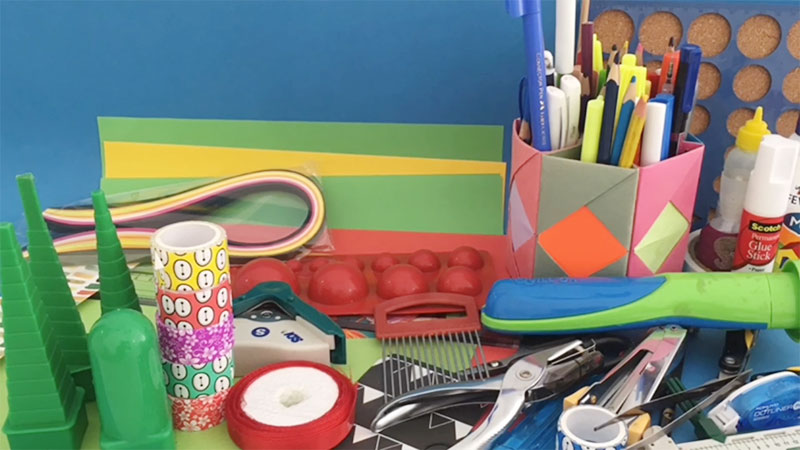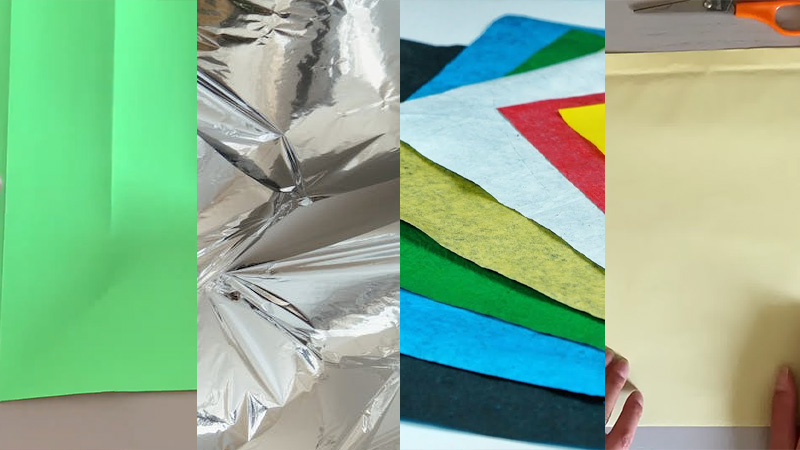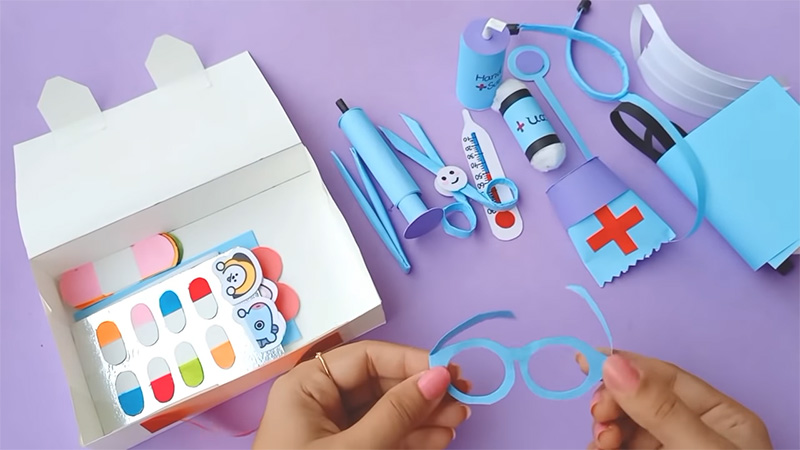Origami, the age-old Japanese art of paper folding, is not limited to just traditional paper.
While origami enthusiasts commonly employ origami paper (kami) for their intricate creations, the world of origami extends beyond conventional boundaries. Diverse materials offer an array of possibilities for this captivating craft.
From the delicate grace of tissue paper to the reflective allure of foil paper, from the strength of washi paper to the rustic charm of kraft paper, and even the occasional foray into fabric or plastic – the selection of materials for origami is as varied as the folds and forms it can create.
In this exploration, we delve into the intriguing realm of materials for origami, unveiling the versatility and creativity it unlocks.

What Are Some Materials for Origami? -Origami Materials and Uses
Origami can be created using various materials, and the choice of material often influences the appearance, durability, and purpose of the origami creation.
While the traditional and most common material used for origami is paper, there are a variety of Origami materials and uses that can be employed to create intricate and beautiful origami creations.
Here are some of the common origami tools and materials and their uses:
Origami Paper
Origami paper is the most common and traditional material used for folding. It’s available in a wide range of colors, sizes, and patterns.
Origami paper is versatile and suitable for a wide variety of origami projects, from simple animals to complex modular origami structures.
Tissue Paper
Tissue paper is lightweight and delicate, making it suitable for creating intricate and delicate origami designs. It’s often used for folding flowers and other decorative origami pieces.
Foil Paper
Foil paper has a shiny and reflective surface, making it ideal for creating eye-catching origami projects. It’s often used for folding stars, jewelry, and decorative items.
Washi Paper
Washi paper is a traditional Japanese paper known for its strength and texture. It’s commonly used for creating more advanced origami models, as it can hold complex folds and shapes.
Kraft Paper
Kraft paper is sturdy and has a natural brown color. It’s often used for creating origami boxes, packaging, and other utilitarian origami designs.
Newspaper
Recycled newspapers can be used for larger origami projects or for practicing folding techniques. It’s an eco-friendly option for origami enthusiasts.
Magazine Pages
Old magazine pages can provide colorful and textured origami paper. They are great for folding modular origami or abstract designs.
Fabric
Fabric origami, known as “kiriori” in Japanese, involves folding and cutting fabric to create three-dimensional shapes. It’s used for creating origami-inspired fabric sculptures and textile art.
Money
Folding currency bills into origami shapes is a popular and creative way to give money as a gift for special occasions. Common origami money folds include butterflies, shirts, and hearts.
Plastic Sheets
Transparent plastic sheets, such as acetate or overhead projector sheets, can be used for creating origami that needs to be more durable or waterproof. This is often used in outdoor origami displays.
Polymer Clay
While not traditional origami material, polymer clay can be used to create origami-inspired sculptures.
Artists fold and shape the clay to mimic origami designs and then bake it to harden the sculpture.
Natural Materials
Some artists experiment with natural materials like leaves, bark, and twigs to create origami-like sculptures. This combines the principles of origami with elements of nature.
Metal Sheets
For more advanced and artistic origami projects, metal sheets can be used. Metal origami often requires specialized tools and skills and is used for creating intricate sculptures.
Advanced Origami Materials

Advanced origami often involves using specialized materials to create intricate and complex origami designs.
While traditional origami uses plain paper, advanced practitioners may explore a variety of materials to achieve their desired results.
Here are some advanced origami materials:
Tant Paper
Tant paper is a high-quality origami paper originating from Japan. It is known for its durability and ability to hold creases well. Tant paper comes in various colors and is often used for complex origami models.
Washi Paper
Washi paper is another type of Japanese paper, made from plant fibers such as mulberry. It is known for its strength and texture, making it suitable for complex folding techniques. Washi paper comes in various patterns and is often used for artistic origami creations.
Foil Paper
Foil paper is regular origami paper with a metallic foil layer on one side. This material adds a shiny, reflective quality to origami models, making them visually appealing.
Foil paper is commonly used for folding insects and other models that require a metallic appearance.
Tissue Foil
Tissue foil is a combination of tissue paper and aluminum foil. It is known for its flexibility and strength, making it ideal for complex and detailed origami designs. Tissue foil is often used for shaping curves and organic shapes.
Kraft Paper
Kraft paper is a sturdy and brown-colored paper that can be used for more substantial origami projects.
It is often used for modular origami, where multiple units are folded and assembled to create larger structures.
Double-Sided Paper
Some origami paper comes with different colors or patterns on each side. This is useful for models that require contrasting colors or designs, such as koi fish or reversible origami.
Wet-Folding Paper
Wet-folding involves dampening the paper to make it more pliable and then folding it to create curved and sculptural shapes.
Special wet-folding paper is designed for this technique, allowing origamists to create more organic and realistic forms.
Metallic and Vellum Papers
These papers have unique textures and finishes, adding depth and character to origami models. They are often used for crafting origami jewelry or decorative items.
Parchment Paper
Parchment paper is translucent and can be used to create delicate and ethereal origami designs. It’s commonly used for folding lanterns or models that require a soft, diffused light effect.
Sculpture Paper
Some origami artists use specially designed sculpture paper that is thicker and more resilient. It allows for intricate shaping and manipulation to create three-dimensional sculptures.
Fabric Origami
Advanced origamists sometimes experiment with fabric materials, combining traditional origami techniques with textiles to create unique and textured origami pieces.
Metal Origami
In extremely advanced origami, artists may explore folding thin sheets of metal to create intricate and durable origami sculptures. This requires specialized tools and techniques.
Does Origami Use Scissors?

Traditional origami typically does not involve the use of scissors. One of the fundamental principles of origami is to create intricate and beautiful shapes solely through the art of folding paper.
The goal is to transform a single square sheet of paper into a desired figure or design without the need for cutting or gluing.
Origami artists and enthusiasts often pride themselves on their ability to craft intricate and complex designs using only folding techniques. Adhering to the “no scissors, no glue” rule is a hallmark of traditional origami.
However, there are variations of paper folding that incorporate cutting into the process. These forms are known as “kirigami.” Kirigami allows for both folding and cutting of the paper to create more complex and detailed designs.
While kirigami shares some similarities with origami, it is considered a distinct art form due to its use of scissors.
Does Origami Use Glue?
Traditional origami does not involve the use of glue. One of the fundamental principles of origami is to create intricate and beautiful shapes solely through the art of folding paper.
The goal is to transform a single square sheet of paper into a desired figure or design without the need for cutting, gluing, or any additional tools.
Origami artists and enthusiasts take pride in their ability to craft intricate and complex designs using only folding techniques.
The “no cutting, no glue” rule is a key aspect of traditional origami and distinguishes it from other paper crafts.
However, there are variations and modern adaptations of origami that may incorporate glue or other materials for specific purposes.
For instance, modular origami, which involves assembling multiple folded units to create complex structures, might use a small amount of glue to secure the units together for stability.
Additionally, when origami is used for practical or decorative purposes beyond traditional art (such as in origami-based crafts or as part of mixed-media art), glue and other adhesives may be employed as needed.
FAQS
Can I use recycled materials for origami?
Yes, you can use recycled materials such as old newspapers, magazines, or even discarded packaging materials like cardboard for eco-friendly origami projects.
Is it possible to use transparent materials for origami?
While less common, you can use transparent materials like acetate sheets or vellum to create unique see-through origami designs, often used for special decorative effects.
What are the best materials for origami that need to withstand moisture?
If you need your origami creation to be water-resistant, consider using synthetic papers like Tyvek or Yupo, which can withstand moisture and be suitable for outdoor or aquatic-themed origami projects.
Are there any restrictions on material thickness for origami?
Origami typically uses thin and pliable materials, but thicker paper or cardstock can be used for specific projects.
Can I combine different materials in a single origami project?
Yes, you can combine various materials to create visually striking mixed-media origami.
To Recap
In origami, materials serve as both the canvas and the paintbrush, allowing artists to breathe life into their creations.
While traditional origami paper remains the bedrock of this ancient art form, the spectrum of materials available for experimentation is wide and diverse.
From the fragile grace of tissue paper to the resilience of plastic and the timeless elegance of washi paper, each material offers unique textures, colors, and possibilities.
These materials enable artists to push the boundaries of creativity, producing origami pieces that transcend tradition and captivate the imagination.
The choice of material is not just a practical consideration; it’s an artistic decision that defines the essence of each origami masterpiece.
Leave a Reply